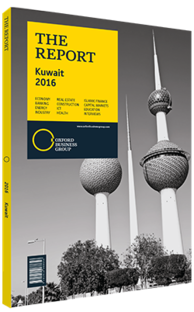Kuwaiti government plans to move ahead with major projects
Lower oil prices have significantly affected the Kuwaiti government’s fiscal position. Oil and gas exports make up 90% of public spending. The recent decline in energy prices has resulted in lower oil export revenues, which are projected to fall from $112.9bn in 2012 to $51bn in 2016, according to December 2015 data from the IMF. Tumbling oil prices and reduced revenues have triggered calls from Kuwait’s highest authorities for the parliament and Cabinet to agree on ways to shift the country’s fiscal trajectory. In October 2015 Emir Sheikh Sabah Al Ahmad Al Jaber Al Sabah told the Kuwait National Assembly, “The decline in global oil prices has caused state revenues to drop by around 60%, while spending remained without any reduction, leading to a huge deficit.”
Strong Foundations
In spite of the reduced revenues of recent years, Kuwait still stands on firm financial footing. After transferring 25% of total revenues, excluding investment income, to the country’s Future Generations Fund, the fiscal balance declined to a deficit equalling 4.4% of 2014/15 GDP, down from a surplus worth 11.7% of GDP in 2013/14, according to the IMF’s 2015 Article IV consultation. In July 2015 Parliament approved a state budget for the 2015/16 fiscal year, which ended in March 2016.
Nearly half of the budget’s expenditures, or KD8.18bn ($27.1bn), was deficit spending. As for the 2016/17 fiscal year, the government has submitted a budget for parliamentary approval that includes KD18.9bn ($62.5bn) in spending, Anas Khaled Al Saleh, the deputy prime minister, announced in January 2016. The country has largely opted to cut current spending levels only slightly, by 1.6%, leading to an estimated deficit of KD11.5bn ($38.03bn).
Modest Proposals
Still, in the face of lower oil prices, the authorities are examining options for more sustainable spending levels in the long term, dipping into Kuwait’s hefty reserves, reducing subsidies and introducing new taxes. Thanks to surpluses in recent years, Kuwait has as much as $600bn in reserves, which it could draw on if needed. However, spending from reserves is seen as a useful but temporary solution. The decline in energy revenues presents an opportunity in disguise, providing stakeholders with extra impetus to begin shifting public spending towards a more sustainable path.
Some small measures have already begun to plug the fiscal hole. The Kuwaiti authorities immediately took some steps to trim spending, liberalising diesel and kerosene prices, and reducing aviation fuel subsidies in January 2015. The fuel pricing changes alone saved the government 0.3% of annual GDP, according to the IMF. The authorities have also moved to reduce medical allowances for Kuwaitis travelling abroad for care while also cutting back on travel and other allowances for public sector employees. The bulk of the budget goes toward subsidies for basic goods, public salaries and other forms of compensation that total KD13.3bn ($44bn), or about 70% of public spending. Indications are that any changes made to subsidies will be cautious, since government representatives have been keen to reassure that nationals on low incomes will not be negatively affected.
Next Step
In addition to cutting spending, the authorities have looked into raising revenue through the introduction of value-added tax (VAT). In February 2016 the GCC agreed to implement a region-wide VAT, a consumption levy that could help shore up government revenues by as much as 2% of GDP, according to Christine Lagarde, managing director of the IMF, who spoke at a GCC taxation conference in Abu Dhabi. A VAT framework has been drafted and is expected to be signed by the end of 2016, with actual implementation set for between 2018 and 2019. Kuwait’s government is also considering an increase in corporate taxes for local firms. Overall, the outlook seems optimistic for Kuwait’s fiscal situation, with the authorities focusing more on spending and subsidies.
You have reached the limit of premium articles you can view for free.
Choose from the options below to purchase print or digital editions of our Reports. You can also purchase a website subscription giving you unlimited access to all of our Reports online for 12 months.
If you have already purchased this Report or have a website subscription, please login to continue.

